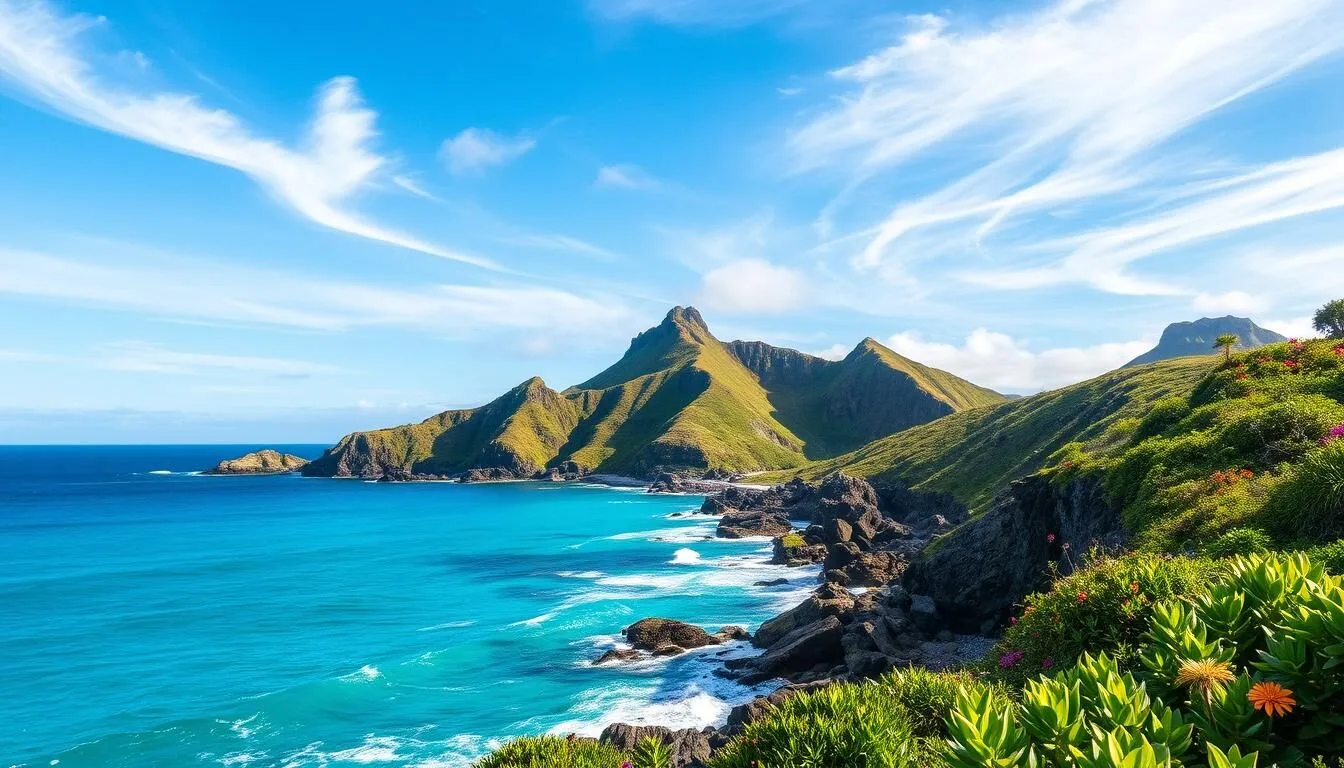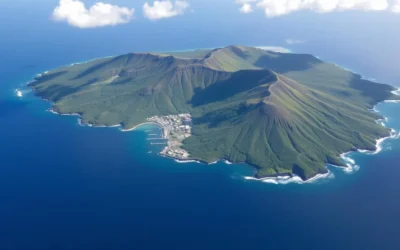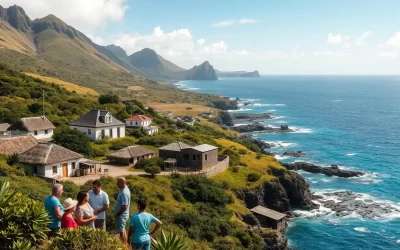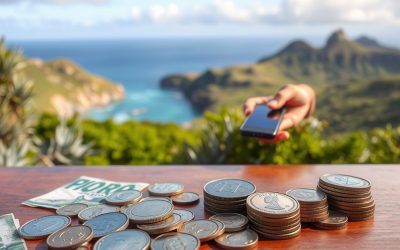✓ Accommodations✓ Flights✓ Rental Cars
Did you know that Pitcairn Island, with its population of less than 50 residents, is one of the most remote inhabited islands in the world? This isolation, combined with its unique geographical location, creates a distinct climate that varies significantly throughout the year.
Understanding the weather patterns is crucial for planning a successful trip to this island paradise. The period from January to April is generally considered the prime time to visit, offering clearer skies and less rainfall, making it ideal for outdoor activities and enjoying the island’s natural beauty.
To make the most of your experience, it’s essential to consider the island’s climate variations throughout the year, including temperature patterns, rainfall, and wind conditions.
Understanding Pitcairn’s Unique Climate
Pitcairn Island boasts a distinct climate shaped by its remote location in the Pacific Ocean. This unique climate is a significant factor in making Pitcairn an attractive destination for travelers seeking a serene and picturesque environment.
Geographic Location and Its Impact on Weather
Pitcairn’s geographic location significantly influences its weather conditions. The island’s subtropical climate is moderated by the surrounding ocean, resulting in relatively stable temperatures throughout the year. The warm waters of the Pacific Ocean surrounding Pitcairn contribute to its mild climate, making it an ideal destination for those seeking pleasant weather.
Year-Round Temperature Patterns
Pitcairn enjoys a moderate climate with temperatures ranging from 60°F to 85°F (16°C to 29°C) throughout the year. The warmest months are January through March, with average highs around 85°F (29°C), while the coolest temperatures occur during July and August, when readings may drop to around 60°F (16°C) at night. The minimal annual temperature variation of about 25°F makes Pitcairn comfortable for visitors year-round.
| Month | Average High Temperature (°F) | Average Low Temperature (°F) |
|---|---|---|
| January | 85 | 70 |
| July | 75 | 60 |
| August | 75 | 60 |
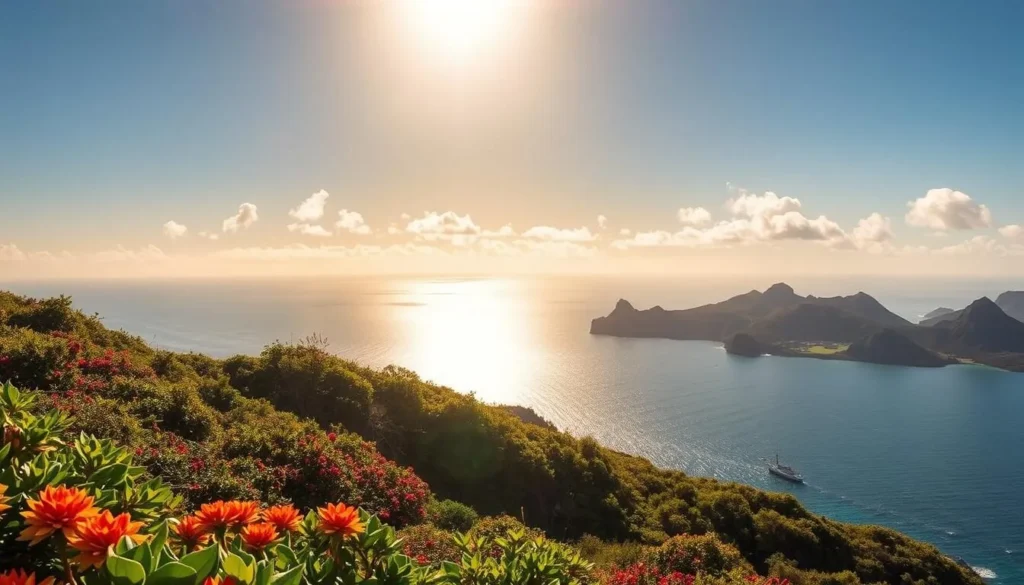
Pitcairn: Best Months for a Weather-Savvy Trip
To make the most of your trip to Pitcairn, it’s essential to identify the best months to visit based on your weather preferences. Understanding the seasonal patterns will help you plan a more enjoyable and comfortable journey.
January to April: The Prime Visiting Window
The months from January to April are considered the prime visiting window for Pitcairn Island. During this period, the weather is generally more favorable, with warmer temperatures and lower rainfall compared to other months. This makes it an ideal time for outdoor activities such as snorkeling, diving, and exploring the island’s natural beauty. You can enjoy the island’s serene landscapes and participate in various activities without the hindrance of harsh weather conditions.
Shoulder Seasons: May-June and November-December
For travelers looking for a balance between favorable weather and fewer crowds, the shoulder seasons of May-June and November-December are worth considering. These transitional months offer gradually changing weather patterns as the island moves between the wet and dry seasons. May and June mark the transition into slightly cooler temperatures, while still offering many days suitable for outdoor activities. On the other hand, November and December represent the transition out of the wettest period, with conditions improving toward the drier season.
- The shoulder months can offer value for budget-conscious travelers, with potentially lower accommodation rates and fewer visitors, making your trip more cost-effective.
- These periods provide a good compromise for weather-conscious travelers who wish to avoid the extremes of the wet and dry seasons.
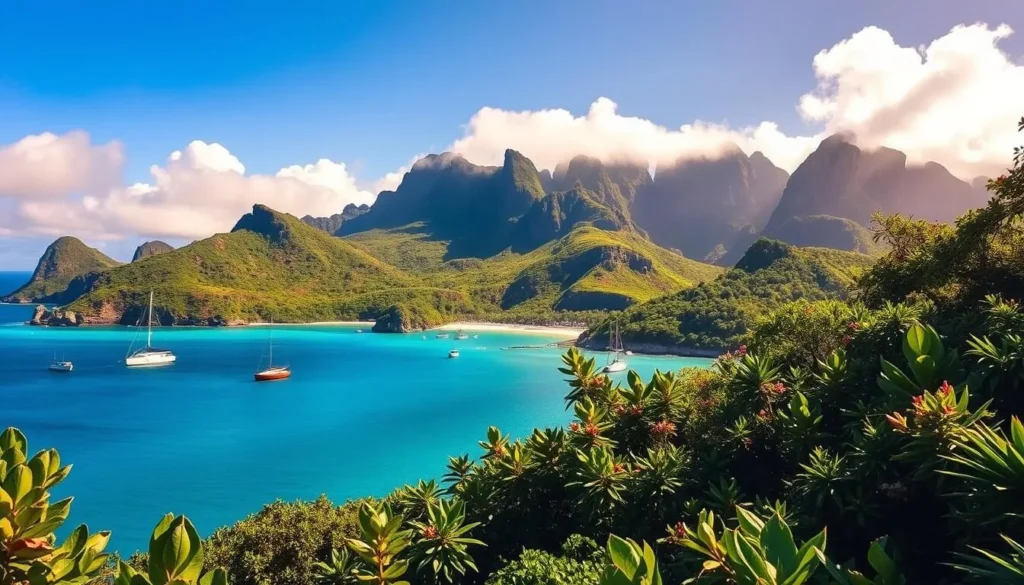
Rainfall Patterns Throughout the Year
Visitors to Pitcairn should be aware of the island’s distinct wet and dry seasons to make the most of their trip. Understanding these patterns can help you plan your activities and make the most of the island’s unique weather conditions.
Wet Season: April to December
The wet season on Pitcairn Island spans from April to December, with the most significant rainfall occurring during these months. This period is characterized by increased precipitation, with some months averaging 8-10 inches of rain. While the rain can make the island’s landscapes particularly lush, it may also limit some outdoor activities.
Drier Months: January to March
From January to March, Pitcairn experiences its dry season, with February being the driest month. This period is ideal for outdoor activities such as hiking the island’s trails and exploring historical sites due to the more consistent weather patterns and reduced rainfall. February averages just 3-4 inches of rain, making it an excellent time for visitors who prefer drier conditions. The morning and evening hours typically offer the clearest weather, even during these drier months.
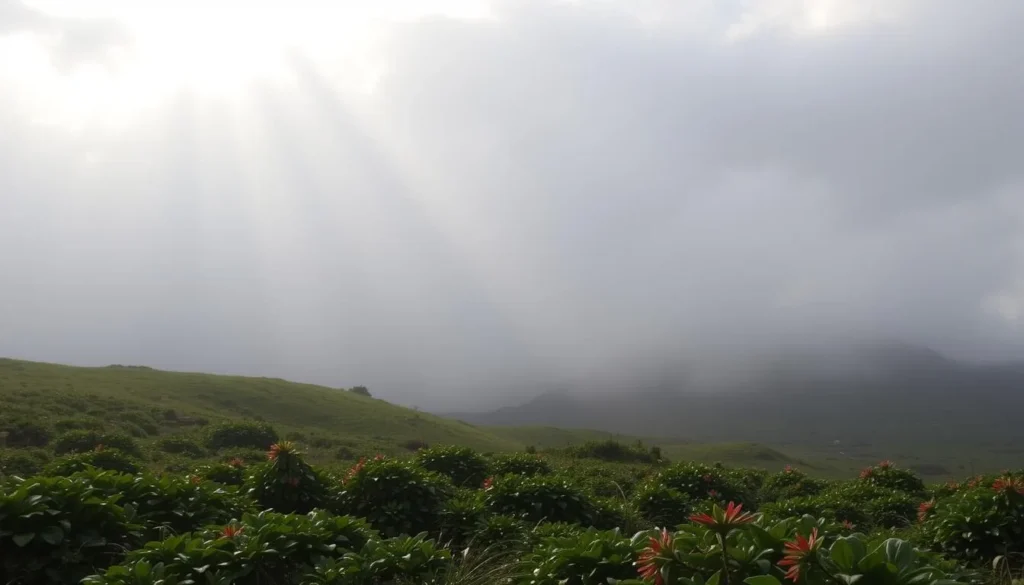
By understanding Pitcairn’s rainfall patterns, you can better plan your trip and enjoy the island’s unique landscapes and activities. Whether you’re looking to hike, explore historical sites, or simply enjoy the island’s natural beauty, knowing what to expect from the weather can enhance your overall experience.
Sunshine and Cloud Cover by Month
As you plan your trip to Pitcairn, it’s vital to know what to expect in terms of sunshine and cloud cover. The island’s weather patterns significantly impact the quality of your visit, making it essential to understand these factors.
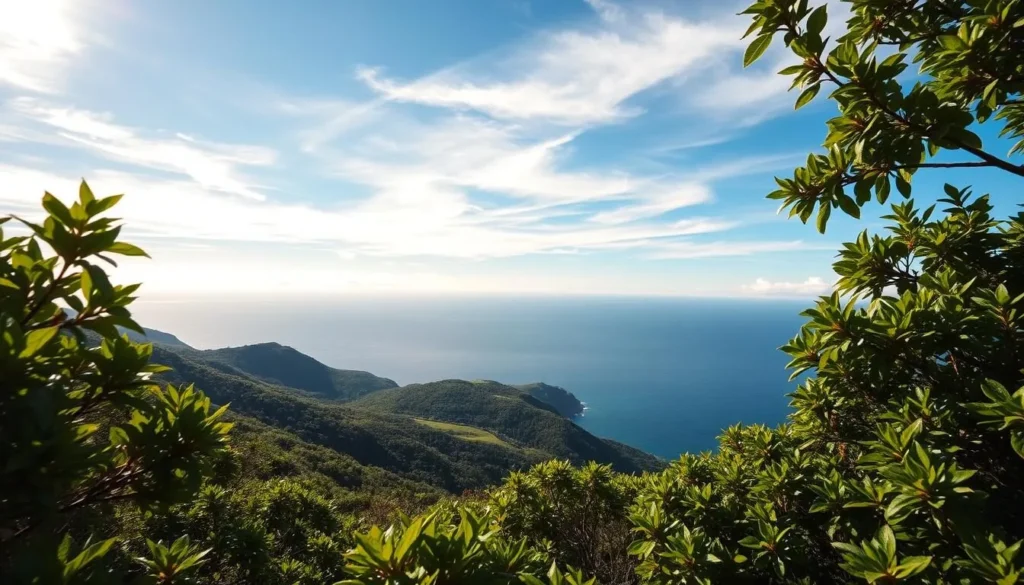
Clearest Skies: February and March
The months of February and March offer the clearest skies on Pitcairn Island, making them ideal for outdoor activities and sightseeing. During this period, you can expect plenty of sunshine, with minimal cloud cover. It’s a great time to enjoy the island’s natural beauty, from its beaches to its hiking trails.
Overcast Periods: September to November
In contrast, the period from September to November is characterized by increased cloud cover. November is typically the cloudiest month, with overcast conditions occurring approximately 60% of the time. Despite the cloudiness, temperatures remain warm, averaging around 75-80°F (24-27°C). The increased cloud cover correlates with the peak of the wet season, often resulting in afternoon or evening showers. Visitors during this period should plan indoor or cultural activities and remain flexible to take advantage of clearer periods.
Wind Conditions and Their Seasonal Variations
Pitcairn Island’s wind conditions vary significantly throughout the year, impacting visitor experiences. As you plan your trip, it’s essential to understand these variations to make the most of your time on the island.
Windy Season
From November to June, Pitcairn experiences its windy season. During these months, the island is exposed to stronger wind gusts, which can affect outdoor activities. You should be prepared for rougher seas and more challenging conditions during this period.
Calmer Months
In contrast, the calmer months from July to October offer more tranquil conditions, ideal for water activities like snorkeling and diving. Some key benefits of visiting during this time include:
- September is typically the calmest month, with average wind speeds dropping to 8-12 knots (9-14 mph).
- The reduced winds create glassy, tranquil waters around the island.
- These calmer conditions enhance underwater visibility as sediment settles.
- However, these calmer months coincide with the peak of the wet season, presenting a trade-off between calm seas and increased likelihood of rain.
Understanding these wind patterns and their impact on your visit will help you plan a more enjoyable and weather-savvy trip to Pitcairn Island.
Water Temperature and Ocean Activities
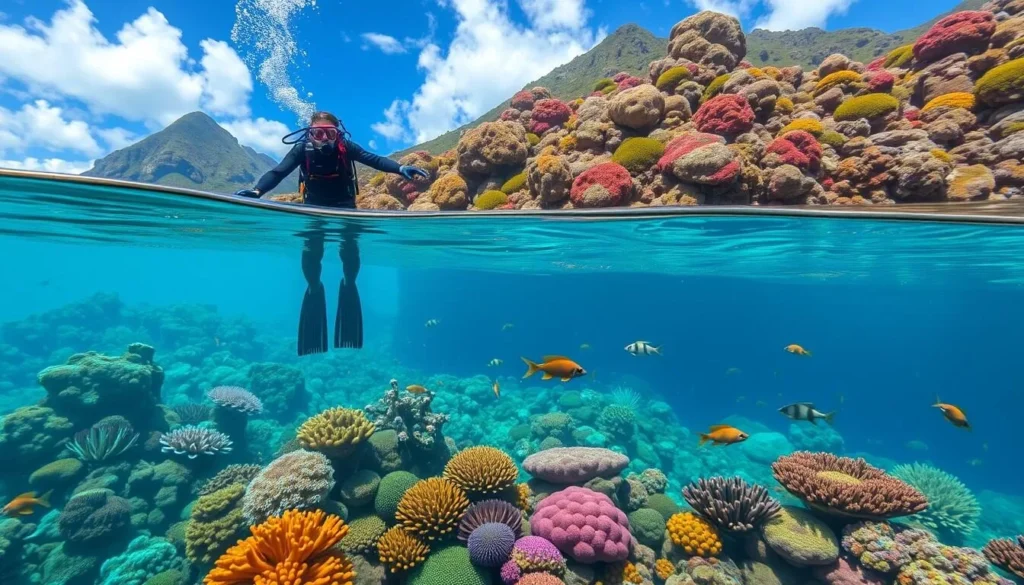
Explore the best times for water activities in Pitcairn, from swimming to diving. The island’s ocean offers a unique experience, with conditions varying significantly throughout the year.
Best Months for Swimming and Snorkeling
The water temperature remains relatively consistent, ranging from 70-80°F (21-27°C) throughout the year, making it ideal for swimming and snorkeling. The best months for these activities are typically from January to April, when the ocean is calmer.
Diving Conditions Throughout the Year
Diving around Pitcairn is possible year-round, though conditions vary. The best diving visibility typically occurs during the drier months from January to March, with visibility often exceeding 100 feet. Marine life is abundant, with certain species like manta rays more commonly spotted during specific seasons.
The calmer wind conditions from July to October can make for smoother boat entries and exits, despite coinciding with the wetter season. This makes it an excellent time for those who prefer fewer crowds.
Humidity Levels and Comfort Factors
To make the most of your time in Pitcairn, understanding the local humidity is key. Humidity plays a significant role in determining the comfort of your activities on the island.
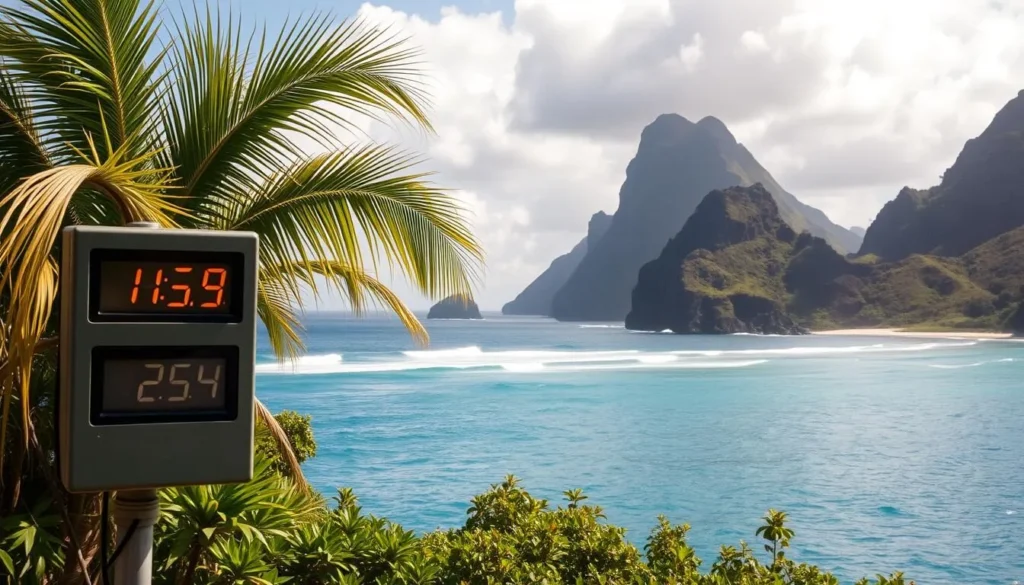
Managing High Humidity
High humidity can be challenging, but there are ways to manage it. During periods of high humidity, it’s advisable to plan your activities during the cooler parts of the day, such as early morning or late afternoon. This can help make your experience more enjoyable.
Beach/Pool Score for Outdoor Activities
The beach/pool score is a useful measure to determine when Pitcairn is at its best for outdoor water activities. Based on this measure, the optimal period extends from early January to early April, with peak conditions in mid-February. This score considers factors like clear skies, comfortable temperatures between 75-85°F, and lower humidity levels. During these months, you’ll experience the most pleasant conditions for beaches, swimming, and outdoor activities. Even during less ideal months, morning hours typically offer better conditions for water-based activities.
The weather conditions during the optimal period make it ideal for enjoying the island’s beautiful beaches and engaging in various outdoor pursuits.
Planning Around Daylight Hours
Maximizing your time in Pitcairn involves understanding and planning around the available daylight. As you prepare for your trip, consider how daylight hours can impact your activities and overall experience.
Sunrise and Sunset Patterns
Pitcairn’s sunrise and sunset patterns vary throughout the year, influencing the length of your day. During the summer months, you can expect longer days with earlier sunrises and later sunsets. In contrast, winter months bring shorter days with later sunrises and earlier sunsets. Understanding these patterns can help you plan your day more effectively.

Maximizing Daylight for Activities
To make the most of your daylight hours, plan your activities accordingly. For instance, early morning hours (6-9 AM) during summer months offer cooler temperatures and beautiful lighting, ideal for photography and hiking. You can schedule cultural activities and indoor explorations during midday when sun exposure and heat are at their peak. Late afternoon hours (4-7 PM in summer) provide another window of comfortable temperatures for outdoor activities.
| Time of Day | Recommended Activities | Benefits |
|---|---|---|
| Early Morning (6-9 AM) | Photography, Hiking | Cooler temperatures, Beautiful lighting |
| Midday | Cultural activities, Indoor explorations | Avoids peak sun exposure |
| Late Afternoon (4-7 PM) | Outdoor activities | Comfortable temperatures |
By planning your activities around daylight hours, you can enhance your overall experience in Pitcairn. Whether you’re looking to enjoy the outdoors or explore cultural attractions, being mindful of the day’s schedule can make a significant difference.
Best Months for Specific Activities

To make the most of your visit to Pitcairn, understanding the optimal time for specific activities is crucial. The island offers a range of experiences, from beach activities to cultural exploration, and the best months for these can vary.
Optimal Times for Beach Activities
The best experience for beachgoers on Pitcairn Islands is typically during the drier months when the weather is more favorable. January to March is considered ideal for beach activities due to the clearer skies and more comfortable temperatures.
During this period, you can enjoy swimming, snorkeling, and other water activities with ease. The calm seas and pleasant weather make it an ideal time for outdoor enthusiasts.
Ideal Periods for Cultural Exploration
Cultural exploration on Pitcairn is possible year-round, but January to April offers the most reliable weather for visiting outdoor historical sites. The January-March period provides more comfortable conditions for walking tours of the island’s historical locations, including the famous Bounty settlement.
- Cultural festivals and community events are typically scheduled during the drier months to ensure better participation.
- For photographers documenting cultural sites and practices, the clearer skies during February and March provide optimal lighting conditions.
- Indoor cultural activities like museum visits and craft demonstrations can be excellent options during the wetter months.
Weather Considerations for Island Hopping
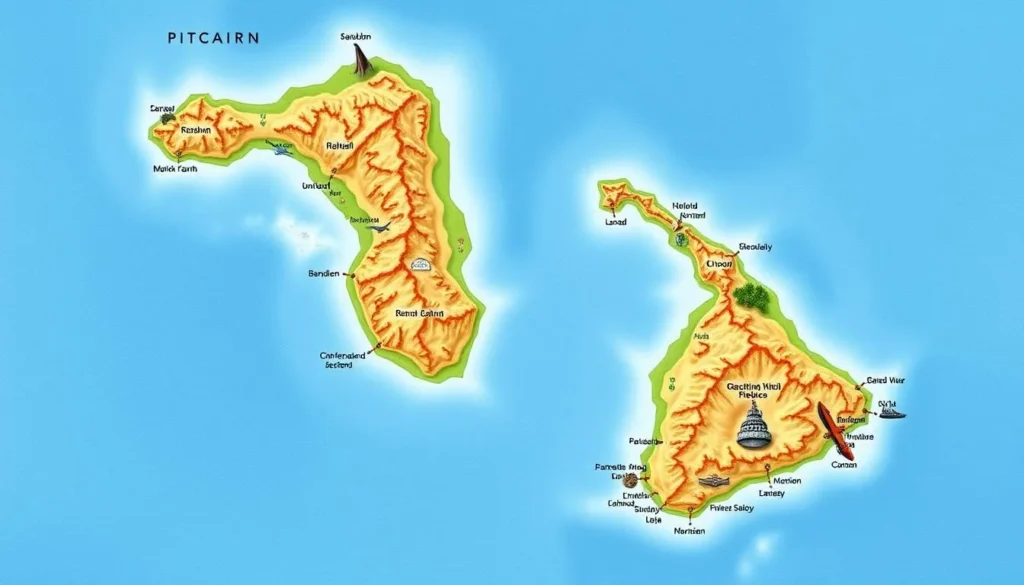
Weather conditions significantly impact island hopping in the Pitcairn Islands, making it vital to plan accordingly. The Pitcairn Islands, including Pitcairn, Henderson, Ducie, and Oeno, offer a unique island-hopping experience. However, the weather can be unpredictable, and understanding its patterns is crucial for a successful trip.
Inter-Island Travel and Weather Impacts
Inter-island travel in the Pitcairn group is heavily influenced by weather conditions. The sea state, wind direction, and rainfall can all impact your travel plans. For instance, the uninhabited islands (Henderson, Ducie, and Oeno) are best visited between January and April, when the weather is generally calmer.
- When planning multi-island itineraries, building in buffer days is essential regardless of the season.
- For itineraries focusing on the uninhabited islands, the January to April period provides the best chance of adhering to planned schedules.
Planning Multi-Island Itineraries
To ensure a smooth island-hopping experience, it’s crucial to plan your itinerary carefully. Consider scheduling at least 2-3 extra days beyond your planned itinerary to accommodate potential weather delays. Additionally, consult with local boat operators about seasonal patterns and their recommendations for multi-island visits.
- Some islands may have restricted landing seasons due to conservation efforts, which should be factored into your travel planning.
- Consulting with local experts can help you navigate these restrictions and make the most of your trip.
Packing Tips for Different Seasons
To ensure a comfortable trip to Pitcairn, it’s essential to pack according to the season you’ll be visiting. The island’s climate varies significantly throughout the year, impacting the type of clothing and gear you should bring.
Essential Items Year-Round
Regardless of the season, there are certain items you should always pack for a trip to Pitcairn. These include comfortable walking shoes, sun protection (sunscreen, sunglasses, hat), and a reusable water bottle to stay hydrated. Packing light, breathable fabrics is also a good idea, as they can help keep you cool during outdoor activities.
For electronics, consider bringing waterproof cases or dry bags to protect against unexpected rain or sea spray. This is a prudent measure for any season, given Pitcairn’s unpredictable weather patterns.
Season-Specific Packing Recommendations
The season you visit Pitcairn will dictate additional items to include in your luggage. For instance, during the windier months (November to June), a light windbreaker or wind shell can be very useful. If you’re visiting during the peak wet season (July to October), pack a lightweight, packable rain jacket or poncho, and consider a small travel umbrella for added protection.
| Season | Recommended Items |
|---|---|
| Windier Months (Nov-Jun) | Light windbreaker, wind shell |
| Peak Wet Season (Jul-Oct) | Rain jacket, poncho, travel umbrella |
| Drier Months (Jan-Mar) | Sun protection, cooling items, breathable fabrics |
| Cooler Months (Jun-Aug) | Light sweater, jacket for cooler evenings |
For the drier months (January to March), focus on sun protection and cooling items like lightweight, breathable clothing. If you’re visiting during the cooler months (June to August), include a light sweater or jacket for cooler evenings when temperatures can drop.

Weather-Savvy Travel Tips for Pitcairn
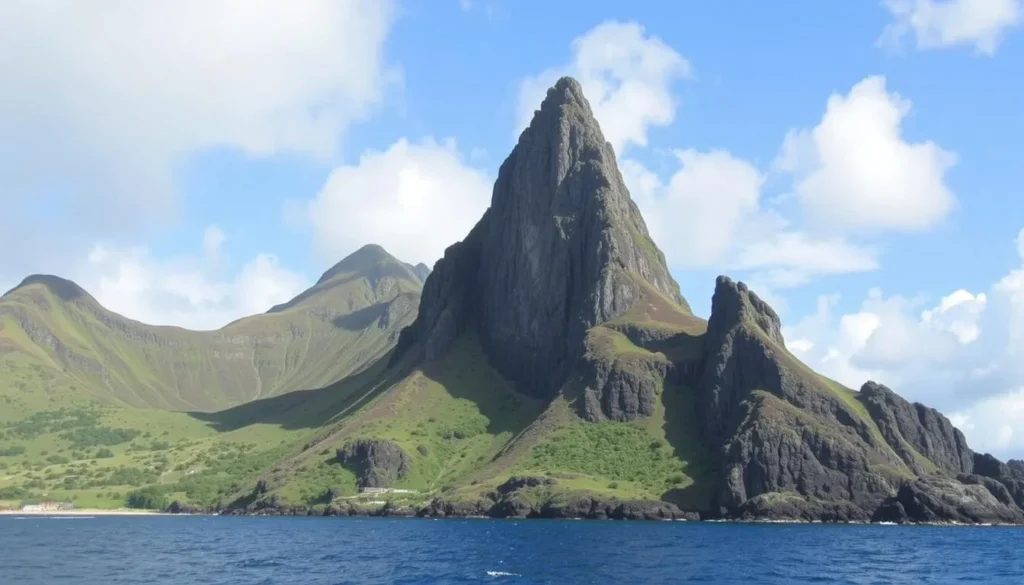
To make the most of your time on Pitcairn, it’s essential to grasp the island’s weather patterns. Understanding and preparing for the local climate will significantly enhance your travel experience.
Monitoring Weather Forecasts
Staying updated with the latest weather forecasts is crucial for planning your activities on Pitcairn. The island’s tropical climate means that weather conditions can change rapidly, and being informed will help you make the most of your trip.
Regularly check local weather updates and be prepared to adjust your plans accordingly. This proactive approach will ensure that you enjoy your time on the island while staying safe.
Dealing with Humidity Year-Round
Pitcairn’s tropical climate means that humidity is a constant factor throughout your trip. To manage humidity effectively:
- Schedule your most active pursuits during early morning or late afternoon when humidity typically decreases.
- Stay hydrated by drinking plenty of water, as high humidity increases perspiration and fluid loss.
- Choose accommodations with good ventilation or fans, as air conditioning is limited on the island.
- Protect electronics and important documents from humidity damage by storing them in sealed containers or waterproof cases.
By being mindful of the humidity and taking necessary precautions, you can enjoy your travel to Pitcairn without discomfort.
Accommodation Options Based on Weather
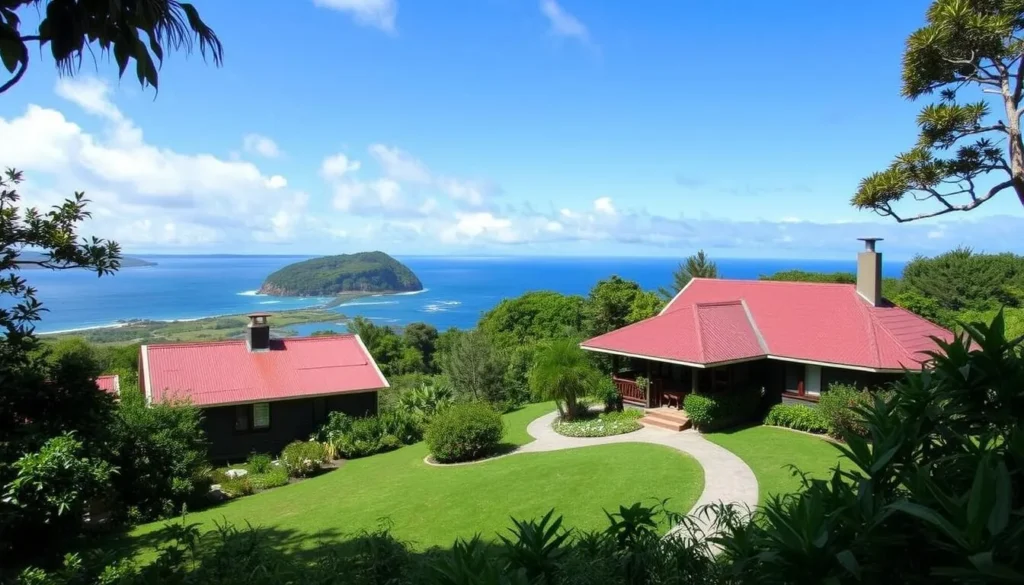
Accommodation in Pitcairn Islands varies, and understanding the weather patterns can help you pick the perfect place to stay. The islands’ unique climate means that some accommodations are better suited to certain times of the year.
Weather-Appropriate Lodging Choices
When visiting Pitcairn, you have several lodging options to choose from, depending on your preferences and the season. During the dry season, from January to April, beachfront accommodations are particularly appealing, offering stunning views and direct access to the beach. In contrast, during the wetter months, opting for a lodge or cottage with indoor common areas and covered porches can enhance your comfort.
Accommodation availability on Pitcairn varies by season, with advance booking being essential during the prime January-April period. It’s recommended to book at least 6-12 months in advance to secure your preferred accommodation during this time.
Booking Considerations by Season
The shoulder and wet seasons offer more flexibility and potentially lower rates for budget-conscious travelers. However, some properties may close or undergo maintenance during the quieter wet season months, limiting your options. When booking for the wet season, prioritize properties with indoor common areas and covered porches to maximize comfort during rain showers.
To make the most of your stay, consider the weather forecast and plan accordingly. Booking the right accommodation at the right time can significantly enhance your experience in Pitcairn Islands.
Transportation to and Around Pitcairn
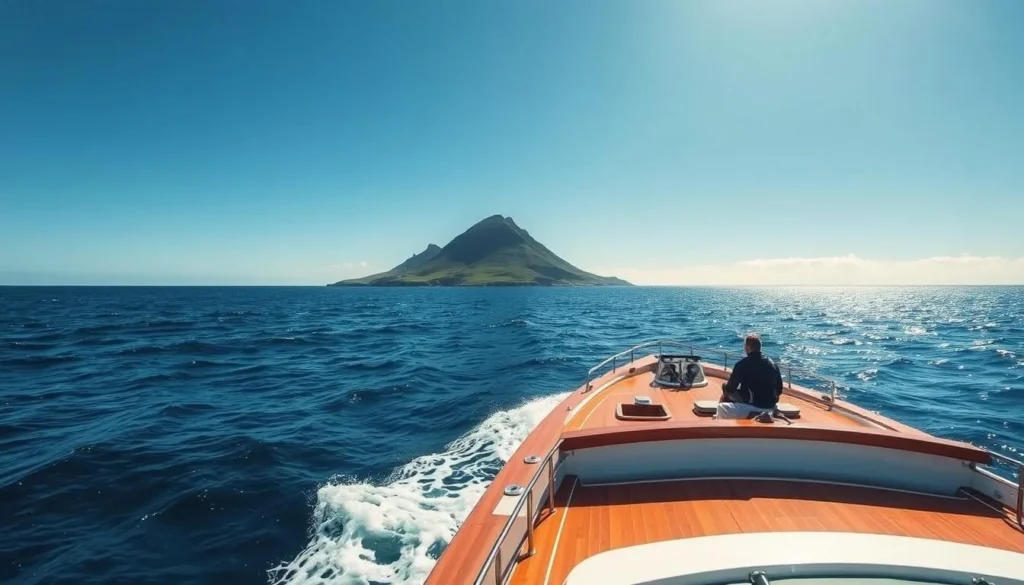
The journey to Pitcairn is part of its charm, but understanding the transportation options and their seasonal variations is key to a smooth trip. You should consider the time of year you plan to visit, as it significantly impacts your travel to and around the island.
Weather Impact on Flights and Boats
The most reliable transportation to Pitcairn occurs during the January to April period, when sea conditions are generally calmer. For travel during the windier months (November-June), building flexibility into your schedule is essential to accommodate potential delays.
Best Transportation Methods by Season
On-island transportation primarily consists of walking, ATVs, and motorbikes. ATV rental is the preferred method during the wet season, while walking is a pleasant option for exploring the 3.5-square-mile island during the drier months. Local boat excursions to nearby diving sites and attractions are most reliable during the February-March period when seas are calmest.
- The most reliable transportation to Pitcairn occurs during the January to April period.
- For travel during the windier months, flexibility is key.
- ATV rental is preferred during the wet season.
- Walking is ideal during the drier months.
- Local boat excursions are most reliable during February-March.
Health and Safety Weather Considerations
The weather on Pitcairn can have a significant impact on your health and safety, so it’s crucial to be informed and prepared. When visiting the island, you’ll need to consider several factors to ensure a safe and enjoyable trip.
Sun Protection and Heat-Related Precautions
During your visit, protecting yourself from the sun is vital. You should pack sunscreen with a high SPF, a hat, and sunglasses to prevent sunburn. Additionally, staying hydrated by drinking plenty of water is essential, especially during the warmer months.
- Use broad-spectrum sunscreen and reapply every two hours.
- Wear lightweight, light-colored clothing that covers your skin.
- Stay in the shade, especially during peak sun hours.
Preparing for Storms and Rough Weather
Although severe storms are rare on Pitcairn, the island can experience rough weather. It’s essential to be prepared for such conditions.
- Follow local advice regarding safe areas and activities during storms.
- Pack an emergency kit with essentials like a flashlight, first aid supplies, and extra water.
- Be aware that communication services might be disrupted during severe weather.
Conclusion: Making the Most of Your Pitcairn Visit
Embarking on a journey to Pitcairn Island means embracing a tropical paradise, where the right time to visit can make all the difference in your travel experience.
By understanding the island’s unique climate and weather patterns, you can plan a trip that maximizes your enjoyment of this remote Pacific destination. The ideal period to visit Pitcairn is from January through April, with February and March offering the perfect balance of dry weather and comfortable temperatures.
Regardless of when you visit, Pitcairn rewards travelers with stunning landscapes, fascinating history, and warm hospitality. By being flexible, preparing for the right conditions, and packing accordingly, you can have a memorable experience in this island paradise. Whether you’re looking for a relaxing getaway or an adventure, Pitcairn Island is sure to leave a lasting impression on your next trip.
The above is subject to change.
Check back often to TRAVEL.COM for the latest travel tips and deals.
